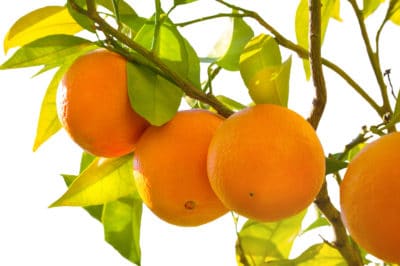Flowering
The flower buds of sweet oranges trees (Citrus sinensis) develop very slowly, beginning in early winter. Depending on where the trees grow in USDA plant hardiness zones 9 through 11, they usually bloom sometime in April.
With proper care, orange trees produce so many flowers that only one in 100 actually gets pollinated. Most simply wither and fall to the ground. It’s Mother Nature’s way of ensuring the trees can support the fruit it sets.
Pollination
Most sweet orange trees have both male and female flowers that self pollinate without help from another tree. The fruit resulting from self pollination always has some seeds.
Navel oranges, however, are parthenocarpic. Their own flowers are infertile. Because their fruit develops from unfertilized eggs, it’s almost always seedless. They tend to produce larger crops with other trees to cross-pollinate them.
Expert gardener’s tip: While wind does a fair job of pollinating orange trees, having bees around to do it is the best way to maximize your harvest.
Maturing
By mid-May, most of a tree’s flowers have turned yellow and fallen to the ground. They leave behind green, blueberry-sized fruits — most of which are also destined to fall during “June drop.” The ones that make it through will eventually become ripe oranges, but just when depends on what kind they are:
- ‘Hamlin’ and ‘Ruby Red’ need seven to nine months.
- ‘Cara Cara’ and ‘Washington‘ navels need 10 to 11 months and nine to 12 months, respectively.
- Depending on cultivar, blood oranges need from eight to 13 months.
- ‘Valencia,’ as the slowest to ripen, needs from 12 to 15 months.
Expert gardener’s tip: These estimates apply to trees growing in at least eight hours of daily sun and loose, consistently moist (but never waterlogged) soil.
Ripe Oranges
Orange-picking season begins in fall. Hamlins and early-ripening navels are usually ready by October. Don’t count on color to determine if they’re ripe. Until cold decreases the chlorophyll in their rinds, they’ll stay green. Just look for firm, heavy fruit of the right size for its variety. If it pulls from the tree without resisting, it’s ripe.
